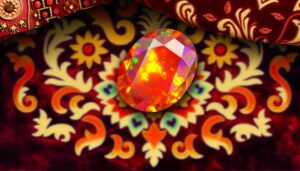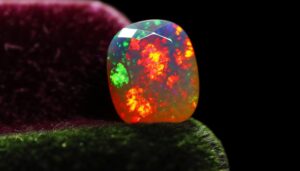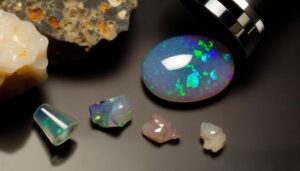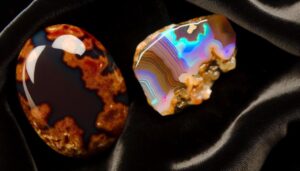Fire Opal Statues – A Comprehensive Guide
Fire opal statues, originating from ancient Mesoamerican civilizations, are crafted using advanced lapidary techniques. Mexican, Brazilian, and Ethiopian fire opals exhibit unique color variations and optical properties.
High-quality fire opals are selected for their play-of-color, clarity, and precision cuts. Master artisans use diamond-tipped tools and diamond abrasives to attain maximum brilliance.
Symbolizing passion and transformation, these statues channel intense emotional energy. When selecting fire opal statues, consider color, clarity, artistry, and ethical sourcing.
Proper care involves avoiding direct sunlight, gentle cleaning, and cushioned storage. Exploring further, you'll discover intricate designs and current trends in fire opal artistry.
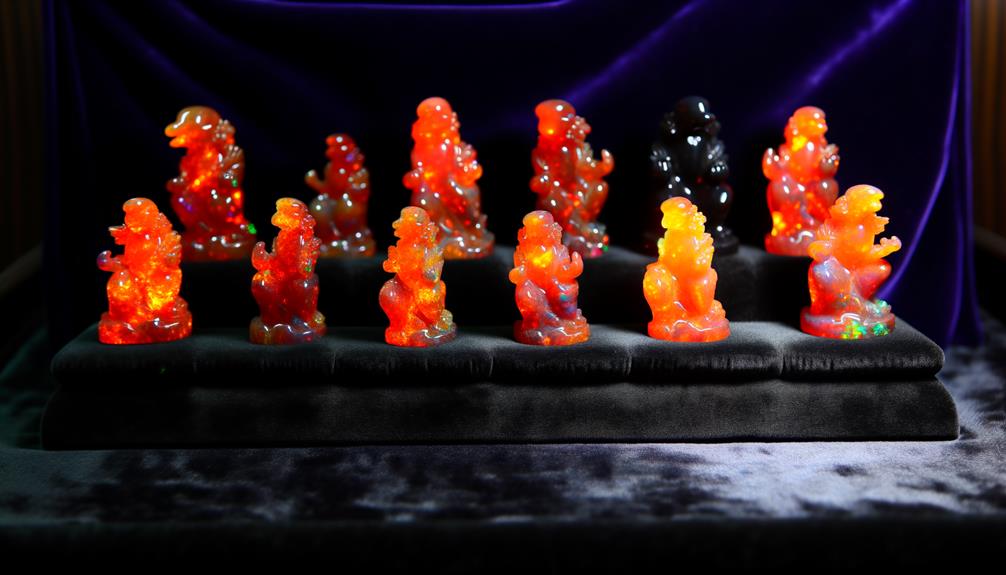
Key Takeaways
- Fire opal statues originated in ancient Mesoamerican civilizations and symbolize deities, passion, and transformation.
- Key fire opal sources include Mexico, Brazil, Ethiopia, and Australia, each offering unique color variations and optical properties.
- Craftsmanship involves precision cutting with diamond-tipped tools and polishing with diamond abrasives and cerium oxide for maximum brilliance.
- Evaluate statues based on color strength, clarity, artistry, size, weight, and ethical sourcing; maintain by avoiding sunlight and cleaning with mild soap.
- Popular designs include geometric abstractions, organic motifs, minimalist contours, cultural symbolism, and mixed media combinations.
History of Fire Opal Statues
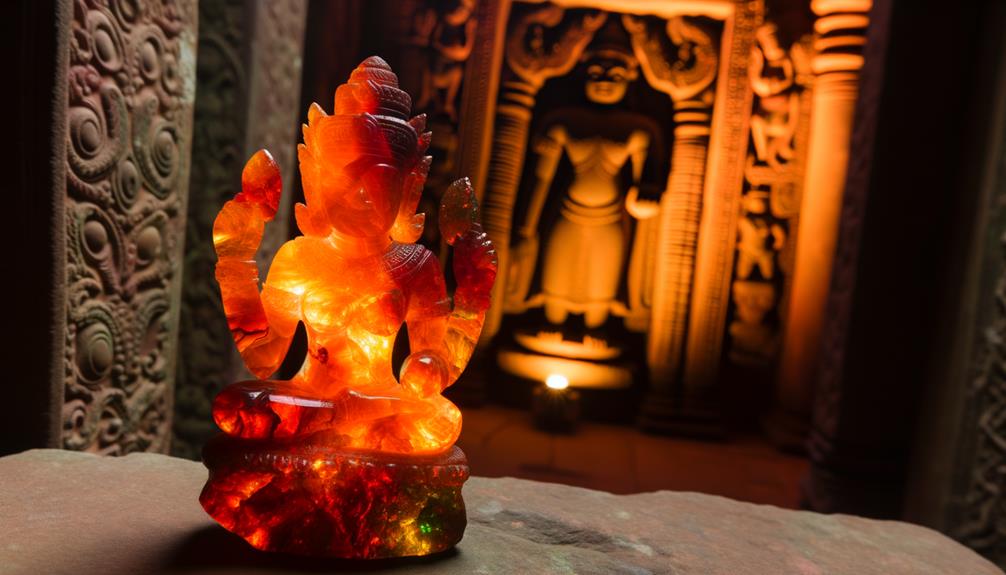
The history of fire opal statues dates back to ancient Mesoamerican civilizations where artisans meticulously crafted these vibrant sculptures for ceremonial and decorative purposes.
You'll find that these artisans employed advanced lapidary techniques to transform rough fire opals into intricate statues. They used tools like obsidian blades and wooden drills, ensuring precision.
The artisans selected fire opals for their vivid color play, symbolizing various deities and natural elements. They often incorporated iconography and motifs significant to their culture, embedding spiritual and cosmological meanings into each piece.
Preservation of these statues involved meticulous storage and protection methods, ensuring their longevity. Understanding this historical context helps you appreciate the craftsmanship and cultural significance behind each fire opal statue.
Types of Fire Opals
You'll encounter various types of fire opals distinguished by their color variations, ranging from vivid reds to warm yellows.
It's important to understand that these gemstones mainly originate from Mexico and Australia, each location imparting unique mineralogical properties.
Color Variations Available
Exploring the vibrant spectrum of fire opals reveals a fascinating array of color variations, each with distinct characteristics and unique appeal. You'll encounter the quintessential fiery reds and oranges, often referred to as Mexican fire opals. These opals exhibit a brilliant play-of-color, showcasing flashes of green, yellow, and blue.
In contrast, Brazilian fire opals generally possess a more subdued palette, featuring warmer hues of yellow, orange, and brown with less prominent play-of-color. Meanwhile, Ethiopian fire opals present a diverse range from translucent yellows to deep oranges, frequently exhibiting hydrophane properties, absorbing water and temporarily altering color.
Each type's unique optical properties and structural composition contribute to their desirability and influence their application in crafting fire opal statues.
Common Source Locations
Understanding the diverse color variations of fire opals naturally leads to an analysis of their primary source locations, which greatly influence their characteristics and quality.
Mexican fire opals, extracted from volcanic regions in Querétaro, display vivid reds and oranges due to high iron content.
Ethiopian fire opals, primarily sourced from the Wollo Province, exhibit a unique hydrophane quality, allowing them to absorb water and change color.
Australian fire opals, though less common, are mined in regions like Lightning Ridge and are noted for their brilliant play-of-color.
Each locale's geological conditions impart distinctive attributes to the fire opals, making it essential to understand these differences when selecting materials for statues.
This knowledge guarantees you choose the best fire opal for your artistic endeavors.
Unique Characteristics Explained
Delving into the unique characteristics of fire opals, you'll find that each type—Mexican, Ethiopian, and Australian—boasts distinct properties that affect their suitability for various artistic applications. Mexican fire opals are renowned for their vivid, warm shades and clarity, making them perfect for intricate designs. Ethiopian fire opals, on the other hand, display hydrophane properties, absorbing water and changing color, which allows for dynamic, evolving art pieces. Australian fire opals, known for their durability and vibrant play-of-color, are ideal for statues requiring longevity and brilliance.
| Type | Key Characteristics | Suitability for Art |
|---|---|---|
| Mexican | Vivid shades, clarity | Intricate designs |
| Ethiopian | Hydrophane properties | Dynamic, evolving art |
| Australian | Durability, vibrant play-of-color | Long-lasting, brilliant statues |
Understanding these distinctions will enable you to select the best fire opal for your artistic vision.
Craftsmanship Techniques
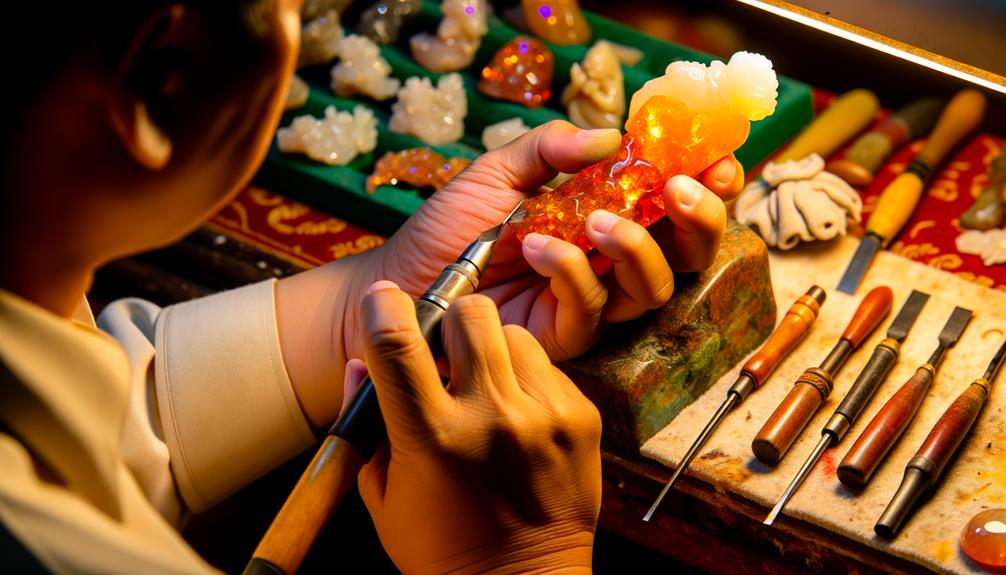
To master craftsmanship techniques for fire opal statues, you must first focus on selecting quality fire opals, ensuring they exhibit vibrant color play and structural integrity.
Next, employ precision cutting methods to bring out the gem's natural beauty while maintaining its fragility.
Selecting Quality Fire Opals
When choosing top-notch fire opals, focus on the gemstone's play-of-color, clarity, and cut to guarantee it meets high craftsmanship standards.
The play-of-color should display vibrant, multicolored flashes, indicating a well-organized internal silica arrangement.
Evaluate clarity by checking for inclusions or cloudiness; high-quality fire opals should be nearly see-through or have minimal inclusions.
The cut must enhance the stone's optical properties, maximizing its visual appeal. Assess the precision of faceting and ensure symmetrical proportions.
Pay attention to the gemstone's polish; a high-gloss finish indicates meticulous craftsmanship.
Precision Cutting Methods
Mastering precision cutting methods is paramount to transforming high-quality fire opals into exquisite statues, demanding meticulous attention to detail and advanced craftsmanship techniques. Utilize diamond-tipped tools, ensuring each cut is deliberate and exact.
You'll need to understand the opal's internal structure, avoiding fractures and maintaining its integrity. Employ a technique called “faceting,” where you create numerous flat surfaces to enhance light reflection. It's critical to maintain consistent pressure and speed to avoid overheating, which can cause cracking.
Use a jeweler's loupe for close inspection, ensuring each cut aligns perfectly with the design. Finally, employ a water-cooled cutting system to minimize thermal stress, maintaining the opal's vibrant color and structural stability.
Polishing for Maximum Brilliance
Achieving maximum brilliance in fire opal statues necessitates a meticulous polishing process that enhances the stone's natural luster and clarity. Start by using a series of progressively finer diamond abrasives, beginning with a coarse grit to eliminate surface imperfections.
Gradually move to finer grits, guaranteeing each stage fully eradicates scratches from the previous one. Maintain consistent pressure and speed to avoid creating flat spots or uneven surfaces.
Utilize a cerium oxide polishing compound for the final shine, applying it with a felt or leather pad. This compound's fine particles interact with the opal's surface, resulting in a high-gloss finish.
Throughout the process, frequently inspect your progress under proper lighting to ensure uniformity and maximal reflectivity.
Symbolism and Significance
Fire opal statues, revered for their vibrant hues and dynamic energy, symbolize passion, creativity, and transformation. These statues channel intense emotional and spiritual energy, igniting a sense of renewal and artistic inspiration. The fire opal's unique composition enhances its metaphysical properties, making it a powerful tool in personal growth and emotional healing.
| Symbolism | Significance |
|---|---|
| Passion | Ignites emotional intensity |
| Creativity | Stimulates artistic inspiration |
| Transformation | Facilitates personal growth |
| Renewal | Encourages emotional healing |
Understanding these elements helps you appreciate the intricate connection between the fire opal's physical properties and its deeper, symbolic meanings. This gemstone's energy can catalyze significant life changes, offering both aesthetic beauty and profound metaphysical benefits.
How to Choose Fire Opal Statues

When choosing fire opal statues, prioritize evaluating the stone's color strength, clarity, and overall artistry to guarantee it meets both aesthetic and metaphysical criteria.
Assess the vibrant play of colors within the fire opal, making sure there are no visible inclusions that might detract from its clarity.
Examine the intricacy and precision of the statue's carving to secure superior craftsmanship.
Key considerations:
Color Strength: Look for a vivid, fiery spectrum.
Clarity: Secure minimal inclusions for maximum brilliance.
Artistry: Evaluate detailed workmanship and precision.
Size and Weight: Proportionate dimensions for intended display.
Source of the Opal: Ethically sourced stones enhance value.
These steps will help you select a fire opal statue that's both visually stunning and energetically potent.
Maintenance and Care Tips
Proper maintenance and care of your fire opal statues guarantees their enduring beauty and energetic properties.
First, avoid direct sunlight, which can cause fading. Place your statue in a shaded, stable environment.
Regularly dust with a soft, lint-free cloth to prevent surface scratches. For deeper cleaning, use lukewarm water and mild soap, gently wiping the surface. Make sure the statue is completely dry before repositioning to prevent moisture damage.
Avoid exposure to harsh chemicals and abrasive materials, as they can erode the opal's surface. Store in a cushioned display case if not in use.
Popular Designs and Trends

As you safeguard the longevity of your fire opal statues through meticulous care, it's equally important to contemplate the popular designs and trends that can enhance both aesthetic appeal and value.
Current trends underscore the utilization of intricate carvings and sophisticated forms. Modern collectors favor designs that incorporate:
- Geometric abstractions: Incorporate angular lines and symmetrical patterns.
- Organic motifs: Emphasize natural elements like leaves, flowers, and animals.
- Minimalist contours: Focus on simple, clean lines with less ornamentation.
- Cultural symbolism: Integrate traditional motifs specific to various cultures.
- Mixed media: Combine fire opal with other materials like metal or wood.
Understanding these trends enables you to make informed decisions that align with market demands, thereby elevating the desirability and investment potential of your collection.
Conclusion
To sum up, diving into the world of fire opal statues is like peeling back layers of vibrant history and intricate craftsmanship. By understanding the types, techniques, and symbolism, you're well-equipped to choose and care for these stunning pieces.
Remember, selecting the right design aligns both aesthetic and spiritual resonance. So, as you venture forth, let your passion for these fiery gems ignite a collection that stands the test of time, gleaming with meticulous care and profound significance.

